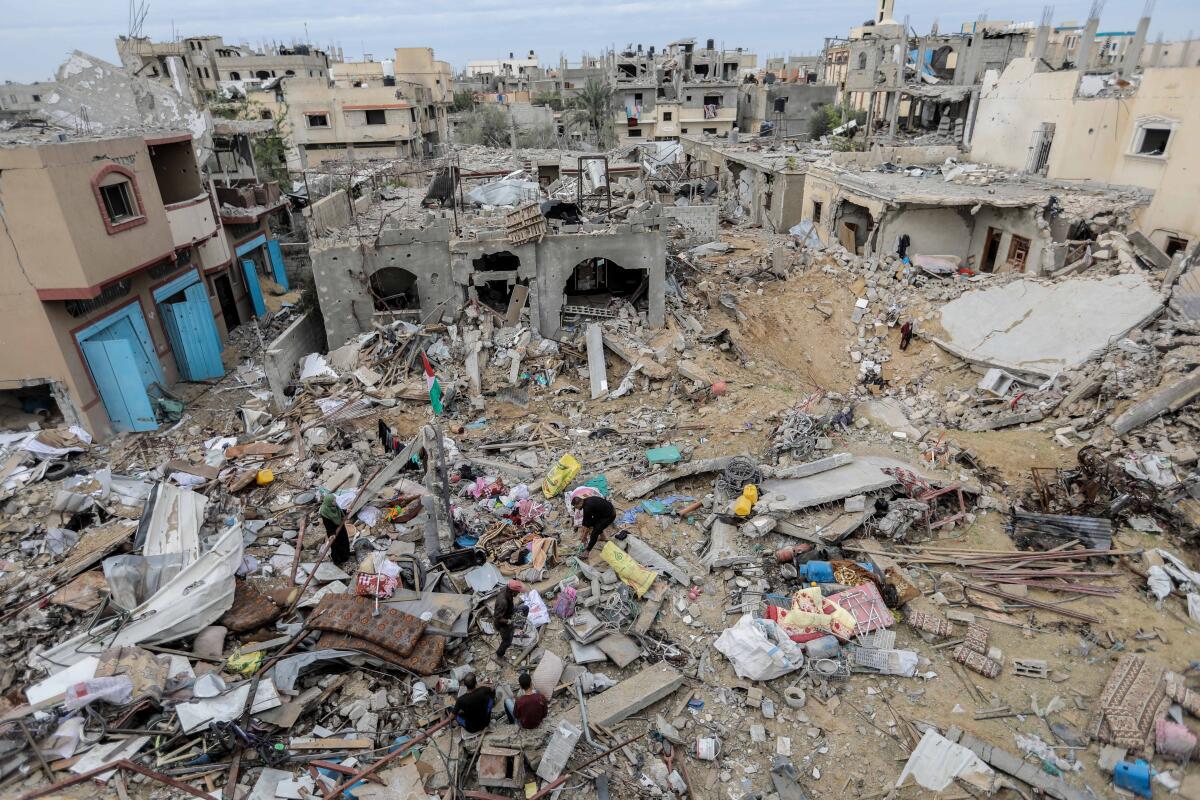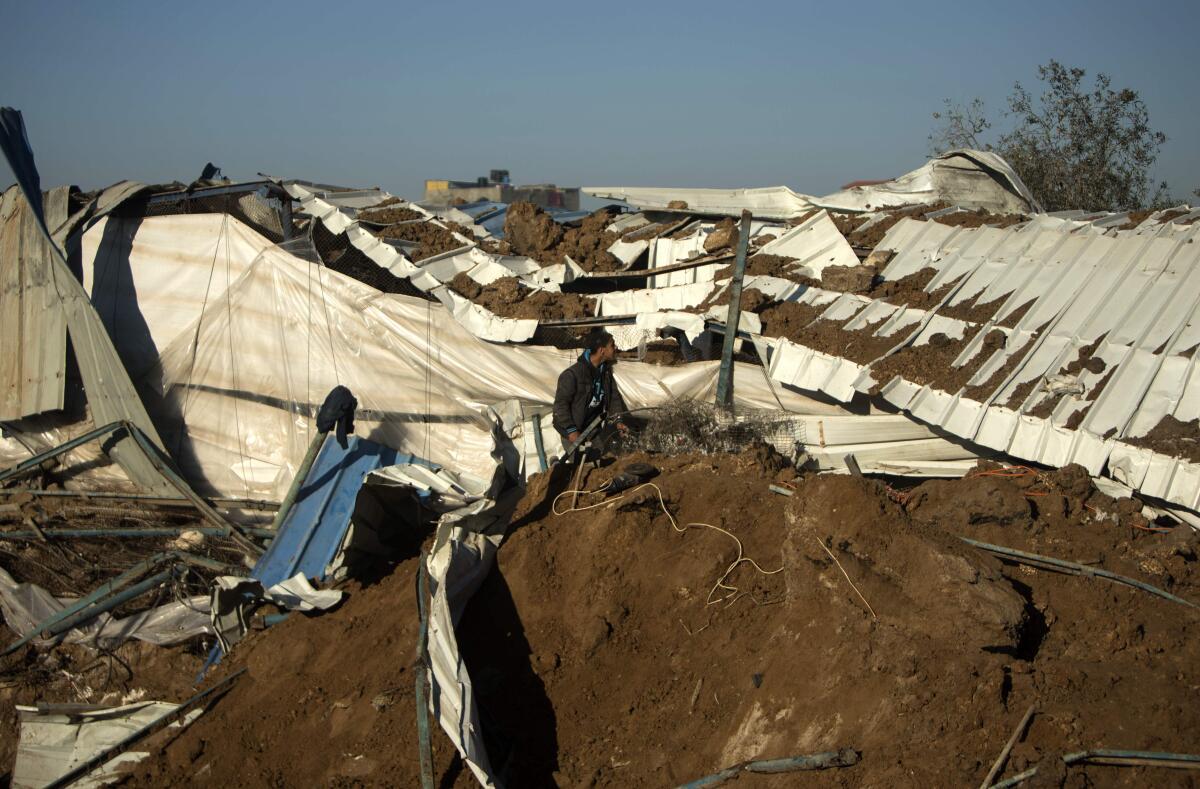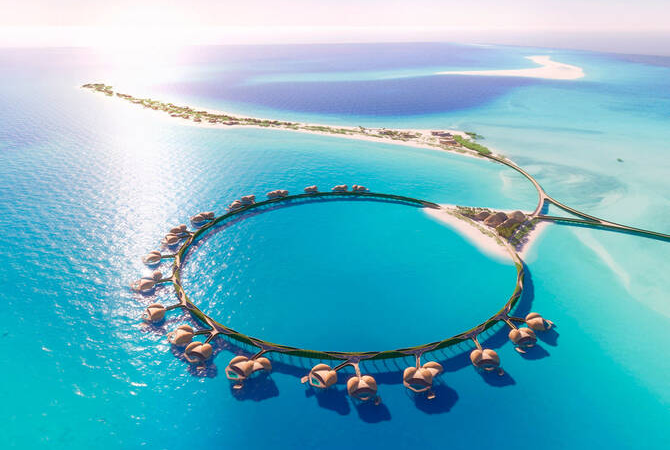Israel is conducting an unseen environmental assault on Gaza.

In October, Israel hit the Jabaliya refugee camp in Gaza with a 2,000-pound bomb twice. The bombs – the second-largest in Israel’s arsenal, according to an investigation by The New York Times – left 40-foot-wide craters in the ground and turned the site into a pile of rubble, killing hundreds.
In the nearly two months since the Israel-Hamas conflict began, Israel has bombarded Gaza without pause, using an array of missiles but also white phosphorus – a compound whose use in densely populated areas violates international humanitarian law, according to Human Rights Watch. In the first month, the Euro-Med Human Rights Monitor recorded that Israel had dropped more than 25,000 tonnes of explosives at 12,000+ targets in the Gaza Strip.
According to the Federation of American Scientists, a body under the U.S. Department of Defence, the 2,000-pound Mk-84 bombs are generally filled with tritonal – a mix of one part aluminium and three parts trinitrotoluene or TNT. When it detonates, the soil, water, and air in the blast radius are all exposed to these substances.
The Gaza Strip is only 41 km long yet has faced decades of repeated bombardment. As a result, the weapons have caused a considerable amount of environmental damage, the effects of which lie beyond what the eye sees.
The chemical components of these bombs are absorbed in the soil or washed into the sea, becoming a dangerous externality that has always languished in the shadow of war. Even the broken buildings – typical of all modern wars – are pollutants. “The destruction seen today in Gaza, after one month, is equivalent to four years of war in Syria,” Marwa Daoudy, an associate professor of international relations and the Seif Ghobash Chair in Arab Studies at Georgetown University, told The Hindu.
This means a large quantity of the materials that are used to make buildings lies on the area’s streets, unsorted and undisposed of. According to a study by PAX, a peace organisation in the Netherlands, rubble from broken buildings includes hazardous materials like asbestos, cement, heavy metals, domestic chemicals, and combustion products, which can cause lung irritation or disease, chest pain, or more serious and chronic nervous and respiratory issues in the case of long-term exposure. Dr. Daoudy said that this “toxic rubble” needs to be cleared out using specific cleaning procedures with specific equipment, since the disposal of such medical and industrial waste and rubble requires special attention to avoid contamination. But because of the blockade Israel imposed in 2007, this is practically impossible.

Palestinian citizens inspect the effects of destruction caused by air strikes on their homes in the Khuza’a area on November 25, 2023 in Khan Yunis, Gaza. | Photo Credit: Ahmad Hasaballah/Getty Images
An ecological blockade
Before Israel’s occupation, the land known as Palestine grew a variety of crops, including grapefruit, strawberries, Jaffa oranges, almonds, watermelon, eggplants, and of course olives. According to one estimate, 45% of arable land in the occupied Palestinian territories is covered by olive trees.
“The olive tree is almost like a spiritual tree that is extremely closely identified with Palestinian life,” said Malini Ranganathan, an environmental justice scholar, political ecologist, and an associate professor at American University’s School of International Service.
But once its occupation began, Israel seized chunks of Palestinian farmland and, as settlements spread, erected barriers, fences, and roads – many of which blocked Palestinians access to their land.
In the 2012 book Challenging Post-conflict Environments, edited by Alpaslan Özerdem and Rebecca Roberts, the duo wrote that during the second Intifada (2000-2005), Israeli forces accused Palestinian farmers of using olive orchards next to Jewish settlements as a “shield and hiding place to attack”. In response, they burnt, cut down or uprooted olive trees. Just in the first year of the second Intifada, the Palestinian Ministry of Agriculture reported 3.74 lakh olive trees had been destroyed by the Israeli army and settlers.
There have also been reports of ‘herbicidal warfare’ in Gaza. Israel is currently working on developing a ‘buffer zone’ – a thin strip of land separating Gaza from itself. In this place, a 2019 report by Forensic Architecture, a research agency at Goldsmiths, University of London, reported, Israeli forces have conducted “unannounced aerial spraying of crop-killing herbicides,” destroying “entire swaths of formerly arable land” and Palestinian farmers’ livelihoods with it.
The Israeli Ministry of Defence confirmed to Forensic Architecture that the spraying, often undertaken during the harvesting period (October-November), is of a combination of glyphosate, Oxyfluorfen, and Diuron. According to the European Chemicals Agency, glyphosate can damage the eyes and threaten aquatic life. Oxyfluorfen can severely irritate the skin and eyes on contact and should be “kept out of water supplies and sewers”. Diuron is a herbicide that works by stifling photosynthesis.
Israel has insisted that the combination is sprayed only along Israel-controlled areas, but the wind often carries it deeper into Gaza. Between November 2014 to December 2018, the Israeli military told Forensic Architecture that it sprayed aerial herbicides along the Gaza border on at least 30 occasions.
Dr. Ranganathan explained that the purpose of this exercise is rooted in Israel’s impression of Gaza’s residents – as being “terrorists from the get go”. So the herbicides are sprayed “to make sure that fences don’t have a thick brush,” allowing military personnel to “see into the other side, and militarily police Gazan residents”. Even the sectioning off of Palestinian territories causes ecological harm, she added: “You need contiguous spaces, you need microclimates, you need those microbiomes to nurture a variety of species. So there’s been an absolute biodiversity loss from fragmentation alone.”

Palestinians inspect the damage to a chicken farm in Gaza City’s eastern suburb of Shujaiya on February 7, 2017, following a series of strikes carried out the day before by Israeli forces against the Hamas movement in the strip in response to a projectile fired from the enclave that hit a border area, according to an Israeli military statement. | Photo Credit: AFP
Othering the olive
Ironically, Israel has created at least 380 nature reserves and 115 national parks. In a research article published in October 2022, Ghada Sasa, of the Department of Political Science at McMaster University, Canada, wrote that these parks were yet another way by which Israel could grab Palestinian land – land that could otherwise be used to plant crops. Many of these parks, according to her, used to be places where indigenous Palestinian and Syrian families used to live.
Israel has also undertaken multiple efforts to reforest the region. Dr. Sasa wrote that 90% of Israel’s forests were grown after the state was created in 1948, with non-indigenous species accounting for 89% of the forest vegetation.
Israeli forces replaced the olive trees and citrus groves its forces destroyed in “the area known as Palestine” with “European pines,” Dr. Ranganathan said. “Pine needles are acidic. So when they fall to the earth, they create inhospitable conditions for other types of vegetation – they are a mono-crop.”
Palestinians have strong cultural as well as memorial ties with olive trees. So to have this Mediterranean landscape replaced with pine “further renders Palestinians as outsiders on that land,” she said.
Sewage on the shore
Israel also controls the water supply to Palestinian territories – and cutting access to clean water, to the Palestinian people as well as to the flora and fauna of Gaza, has become another weapon in Israel’s arsenal. According to UNICEF, only one in 10 people in the Gaza Strip have direct access to safe drinking water.
Dr. Daoudy even accused Israel of deliberately targeting WASH – i.e. Water, Sanitation, and Hygiene – infrastructure.
“In 2020, in the occupied West Bank, 84 of the 849 structures that were destroyed were WASH structures,” she explained. “This is considered civilian infrastructure and [attacking them] is forbidden by the Geneva Conventions. In Gaza, in May 2021, the last military incursion before the current one, [Israel] significantly damaged the desalination plant in Gaza that provided clean water to over 250,000 people.”
Just days after Hamas’s attack in October, Israel announced that it would cut water and electricity supply to Gaza. Aside from making daily life harder, cutting power also allows contaminants to spread in desalination plants, including Escherichia coli bacteria that can cause gastric distress.
The people of Gaza “cannot clean wastewater, they don’t have the means anymore,” Dr. Daoudy continued. “The wastewater plants are either destroyed, or they are not able to import the material to rehabilitate the destroyed plant. So you have raw sewage water which just goes straight into the sea… I’m talking about raw, not clean, not partially – it’s raw. I saw the line going down to the sea and children bathing not far away from it.”
When sewage mixes with seawater, the fisheries become contaminated as well, threatening a major source of income for Gazans: fishing. This is setting aside the fact that the waters off Gaza are at risk of overfishing because Israel’s blockade prohibits them from fishing beyond six nautical miles in the north and 15 in the east.
The occupation proceeds
“The weaponisation of hunger, the weaponisation of water and security, and the use of the ecological infrastructural basis of life to deprive a population,” Dr. Ranganathan said, is often how a colonial occupation proceeds. “One of the first ways you colonise and seize territories is not just to syphon off those resources for yourself but also to make sure that the so-called enemy population or the ‘other’ doesn’t have the basis of life to sustain itself.”
In this sense, damage to the environment inflicts losses on the planet and its elements as well as affects the people – a double whammy, so to speak.
After the US pulled out of Afghanistan, for example, doctors found people living in areas exposed to the effects of repeated bombing, burn pits, disposed military waste, and other sites of intense military activity afflicted by a variety of diseases – from rashes to kidney stones to cancer.
Similarly, studies have shown that in the occupied Palestinian territories, heavy metals in the environment and persisting in wounds have increased the rate of congenital birth defects as well as premature births. An April 2020 study, published in the International Journal of Environmental Research and Public Health, concluded that the “bodily accumulation” of heavy metals – many of which are carcinogens (cancer-causing) and teratogens (interfering with foetal development) – “following exposure whilst residing in attacked buildings” is one factor that predisposes women to negative birth outcomes.
But just like the herbicides sprayed over the buffer zone, the consequences of the ecological violence aren’t restricted to the Palestinian people. “We all share the same air,” Dr. Daoudy said. “Despite the wall, when the coastal aquifer is contaminated in Gaza, it’s an aquifer which is shared with Israelis. It’s not in their interest when there’s saline water coming into the coastal aquifers.” The same goes for the air “polluted with phosphorus bombs”.






